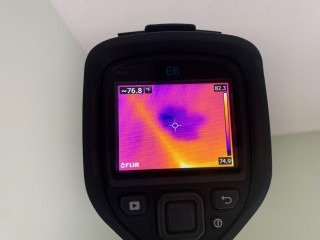[Solved] Does Freezing Mold Kill It
Expert insight by: Brad Fishbein, Licensed Mold Assessor
Updated April 8, 2025
If you've researched mold removal methods, you've likely heard that heat can kill mold spores — but what about the opposite? Can freezing mold actually kill it?
Short answer: Not really.
Freezing may make mold inactive (dormant), but it does not kill mold permanently. In fact, according to the CDC:
"Fungi, including mold, can be stored at -70°C (-94°F) for long-term preservation."
— CDC: Preserving Yeast and Mold Isolates
So while freezing may stop mold from growing temporarily, it’s not a reliable method to kill it. That’s why proper removal and remediation — not just freezing — is the key to eliminating mold from your home.
❄️ Why Freezing Doesn’t Kill Mold
Mold is resilient. While freezing can suppress mold's activity, once temperatures rise and moisture returns, mold comes right back. Here's why freezing doesn't work on its own:
| Factor | Freezing Effect |
|---|---|
| Spores Killed? | ❌ No – Dormant, not dead |
| Growth Stopped? | ✅ Temporarily |
| Risk of Return? | ✅ Yes |
| Safe Indoors? | ❌ Not a practical method |
Instead of using ice or cold temperatures alone, professionals use dry ice blasting — a powerful process combining frozen CO₂, high pressure, and abrasion to remove mold.
🧊 What Is Dry Ice Blasting?
Dry ice blasting is a mold remediation technique that uses pellets of frozen carbon dioxide at extremely cold temperatures (around -110°F or -78.5°C). Unlike regular ice, dry ice sublimates — turning directly from solid to gas, leaving no water behind.
It’s a highly effective way to:
- Strip mold off wood, brick, concrete, or metal
- Reach tight spaces (like in crawl spaces or attics)
- Reduce moisture-related secondary damage
🏛️ EPA Reminder: “Fix the water problem or the mold will come back.”
— EPA: Brief Guide to Mold
🔍 How Freezing + Dry Ice Removes Mold
Dry ice blasting removes mold using 4 physical effects:
| Process | How It Works |
|---|---|
| Speed | Ice pellets hit surfaces at high velocity, dislodging mold |
| Abrasion | Kinetic energy breaks mold’s bond with wood, brick, etc. |
| Thermal Shock | Sudden freezing causes spores to shrink and detach |
| Evaporation | CO₂ turns into gas, expanding and lifting debris away |
The result? Less scraping, no harsh chemicals, and minimal surface damage — especially helpful on wood framing, subfloors, or roof sheathing.
🛠️ When Dry Ice Blasting Works Best
Dry ice blasting is highly effective when:
- Treating mold on framing, sheathing, beams, or subfloors
- Dealing with attic mold, crawl space mold, or large structural infestations
- Sanding or scrubbing would take too long or damage the material
Real-World Example: A 2,000 sq ft attic can often be blasted and cleaned in 1–2 days, while sanding the same area might take 4–5 days and produce more dust.

⚖️ Pros and Cons of Freezing Mold with Dry Ice
| ✅ Benefits | ⚠️ Limitations |
|---|---|
| No secondary waste or water | Requires professional equipment & training |
| Fast, non-invasive | Can’t be used on drywall or soft materials |
| Safe for wood, metal, concrete | Not DIY-friendly |
| Doesn’t damage surfaces when done right | May not fully remove deeply embedded spores |
🔥 Compare to Heat-Based Mold Removal
Wondering how freezing compares to using heat? See our guide on whether heat kills mold for a detailed breakdown of thermal remediation methods.
🧼 When Not to Use Dry Ice Blasting
Freezing mold with dry ice isn’t always the best choice. Avoid this method if:
- 🛑 You haven’t fixed the moisture source
- 🛑 The mold is on drywall, ceiling tiles, or insulation
- 🛑 You plan to DIY — CO₂ gas can be dangerous in poorly ventilated areas
- 🛑 The structure is weak or flaking — high pressure may cause damage
🛑 NY Dept. of Health: “Materials like drywall, carpet, and insulation that have been moldy should be discarded.”
— NY DOH: Mold Removal Guidelines
🧰 How Professionals Use Dry Ice to Remove Mold
Step 1: Containment & Setup
- Use 6 mil plastic sheeting to contain mold spores
- Seal off HVAC vents and entry points
- Set up negative air pressure if indoors
Step 2: Ice Blasting
- Technicians use dry ice guns with various nozzles (fan, precision, etc.)
- Blasting is done on structural wood, subfloors, or sheathing
Step 3: HEPA Vacuum & Sanitizing
- Debris is collected using HEPA vacuums
- Professionals may apply fungicidal sealants to prevent mold return
💡 Tip: After blasting, ask your remediation company if they apply a preventive barrier coating for long-term protection.
✅ Summary: Does Freezing Mold Kill It?
| Method | Kills Mold Spores? | Safe? | DIY Possible? | Lasting Solution? |
|---|---|---|---|---|
| Household Freezing | ❌ No | ✅ Yes | ✅ Yes | ❌ No |
| Dry Ice Blasting | ✅ Yes (removal) | ⚠️ Only by pros | ❌ No | ✅ Yes (if done properly) |
Freezing mold may sound like a quick fix — but only dry ice blasting under professional conditions can truly remove mold from structural surfaces without introducing moisture or damage.
🔗 Related Resources
Explore Related Topics:

Meet the author: Brad Fishbein is an ACAC council-certified Microbial Investigator. In the fall of 2012, he became a Licensed Mold Assessor in the State of Florida through the Department of Business & Professional Regulation. Brad has helped homeowners with over 5,000 successfully completed Mold Inspections since 2009.

